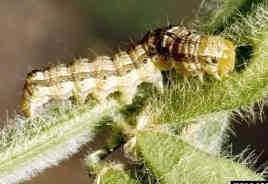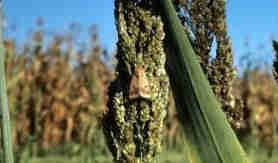By Kelly Hamby, Galen Dively.et.al.
Moth flight activity for the corn earworm, also known as the soybean podworm and one species of sorghum headworm, has increased during the past week. Pest pressure varies across the state and Delmarva region. The early surge in activity is attributed to the record temperatures during June and July, which have accelerated larval development and shortened the generation time of this insect. Corn earworm has already caused significant damage to ears of sweet corn and early planted field corn. Note that Bt hybrids expressing single or multiple Cry proteins no longer control earworms due to the development of resistance; only hybrids expressing the Vip3a Bt protein provide good ear protection. These hybrids represent a relatively small portion of the planted acreage. Thus, significantly more adult moths are now recruited in corn compared to levels a decade ago.
Corn earworms are strongly attracted to and prefer fresh corn silks for egg laying. Outbreaks in other crops often follow a midsummer drought, which causes the corn to ripen earlier and become less attractive to the moths. As early planted corn fields dry down, moths will move into other vegetable and grain crops.
Podworms in Soybeans:

Corn earworm feeding on soybean pod.
In soybeans, female corn earworm moths prefer to lay eggs in open-canopied, late-blooming fields, and are most attracted to soybeans for egg laying from flowering to early pod-set. Drought conditions also delay soybean maturity and prevent normal canopy growth, so peak moth activity is more likely to coincide with blooming of open-canopied fields. In irrigated fields, activity may be greater along pivot tracks and dry corners. Corn earworm larvae can damage flowers; however, because soybeans produce more flowers than needed, flowering sprays are rarely necessary. Podworms cause the most damage when large larvae are feeding on full seed pods with large seeds (see information from NCSU).
What to do? Scout bean fields, paying special attention to those fields with a more open canopy in areas where the nearby maturing corn is no longer attractive to earworm moths.
Sampling should start during mid-August and be repeated at least weekly in each field until a spray decision is made or the pods reach full maturity. Most fields are planted as narrow-row beans, so a 15-inch sweep net is the most practical way to sample for earworms. Walk along the rows, swinging the sweep net so that the opening passes through the foliage. The net is turned 180 degrees after each sweep as you advance with each step to swing the net through the foliage in the opposite direction. Each stroke is counted as one sweep. A series of 25 sweeps should be taken at each of 5 sites in every 40 acres.
Treatment is recommended when counts exceed 3 medium to large podworms per 25 sweeps in narrow row fields, or 5 podworms per 25 sweeps in wide row fields (20 inches or greater). The timing strategy is to wait until most of the larvae are 3/8 inch or more in length, and then treat when pod damage is first evident. This allows for most egg laying and hatching to occur before treatment and reduces the chances of a second spray being needed later. These static thresholds are based on long-term averages for control costs and soybean prices. North Carolina State extension has developed a dynamic online threshold calculator for corn earworm in soybeans that takes into account the sampling method (uses a 15 sweep rather than a 25 sweep sample), row spacing, cost for control, and the value of soybeans, which can be found at:
https://www.ces.ncsu.edu/wp-content/uploads/2017/08/CEW-calculator-v0.006.html
Since the 2008 season, numerous reports of control failures with pyrethroids (Group 3A) used for earworm control have been reported from the Mid-Atlantic region and states to our south. This insect has developed moderate to high levels of resistance to this class of insecticides, so growers need to consider other modes of action. If a pyrethroid (e.g., Brigade, Warrior, Mustang Maxx, Hero, Baythroid, Tombstone) is used, the highest labeled rate timed for small to medium, rather than large worms, is recommended. Alternative classes such as diamides (Group 28; e.g., Coragen, Prevathon), oxadiazines (Group 22A; e.g., Steward) and spinosyns (Group 5; e.g., Blackhawk, Radiant) will be most effective. These materials are also generally softer on beneficial insects which prey upon other late season soybean pests, such as soybean looper and stink bug. ALWAYS read and follow instruction on the pesticide label; the information presented here does not substitute for label instructions.
Headworms in Sorghum:

Corn earworm female in sorghum.
Headworms (corn earworm, fall armyworm, and sorghum webworm) are caterpillar pests that infest grain heads. Flowering or heading sorghum is attractive to corn earworm females for egg laying, and headworm issues have been reported in Southern Maryland this year. Headworms feed on the flowers and developing kernels and large larvae can cause significant yield loss.
What to do? Scout sorghum fields from the end of flowering until hard dough.
Sample heads by bending them into a clean white 5 gallon bucket and beating them to dislodge the headworms. Sample 10 heads per location and sample multiple locations per field. If most larvae are small (up to ¼ inch) sample the field again in 3 to 4 days.
Thresholds vary by the size and species of larvae and sorghum value. In general, 2 corn earworm larvae per head would warrant treatment, and Texas A&M has developed a dynamic online threshold calculator that incorporates cost of control, grain value, anticipated yield (heads/acre), and larval size, which can be found at:
https://agrilife.org/extensionento/sorghum-headworm-calculator/
As mentioned above, pyrethroids (Group 3A) offer poor to moderate control of corn earworm in the Mid-Atlantic, and will not control heavy infestations or large worms. If a pyrethroid (e.g., Brigade, Warrior, Mustang Maxx) is used, the highest labeled rate is recommended. Alternative classes such as diamides (Group 28; e.g., Prevathon), spinosyns (Group 5; e.g., Blackhawk, Tracer), or carbamates (Group 1A; e.g., Sevin, Lannate) will be most effective. Selective insecticides that are less damaging to beneficials are recommended, such as Prevathon (most recommended) or Blackhawk. ALWAYS read and follow instruction on the pesticide label; the information presented here does not substitute for label instructions.
While scouting for headworms, growers are encouraged to look for sugarcane aphid in sorghum as well. Virginia Tech reported the first confirmed identification of white sugarcane aphid in Amelia County on August 1st. For more information on sugarcane aphid see Agronomy News Volume 8 Issue 1. If sugarcane aphids are also present, we strongly advise using selective insecticides to preserve the natural enemies that slow sugar cane aphid population growth.
Source : umd.edu